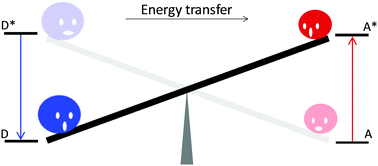Recent advances in energy transfer in bulk and nanoscale luminescent materials: from spectroscopy to applications†
Abstract
Transfer of energy occurs endlessly in our universe by means of radiation. Compared to energy transfer (ET) in free space, in solid state materials the transfer of energy occurs in a rather confined manner, which is usually mediated by real or virtual particles, including not only photons, but also electrons, phonons, and excitons. In the present review, we discuss the recent advances in optical ET by resonance mediated with photons in solid materials as well as their nanoscale counterparts, with focus on the photoluminescence behavior pertaining to ET between optically active centers, such as rare earth (RE) ions. This review begins with a brief discussion on the classification of optical ET together with an overview of the theoretical formulations and experimental method for the examination of ET. We will then present a comprehensive discussion on the ET in practical systems in which normal photoluminescence, upconversion and quantum cutting resulted from ET involving metal ions, QDs, organic species, 2D materials and plasmonic nanostructures. Diverse ET systems are therefore simply categorized into cases of ion–ion interactions and non-ion interactions. Special attention has been paid to the progress in the manipulation of spatially confined ET in nanostructured systems including core–shell structures, as well as the ET in multiple exciton generation found in QDs and organic molecules, which behave quite similarly to resonance ET between metal ion centers. Afterwards, we will discuss the broad spectrum of applications of ET in the aforementioned systems, including solid state lighting, solar energy utilization, bio-imaging and diagnosis, and sensing. In the closing part, along with a short summary, we discuss further research focus regarding the problems and possible future directions of optical ET in solids.


 Please wait while we load your content...
Please wait while we load your content...